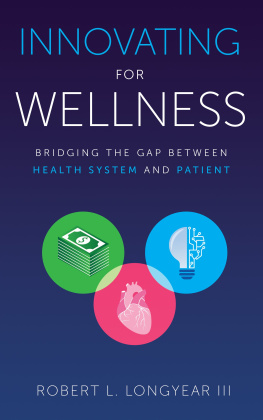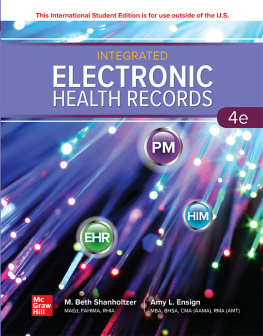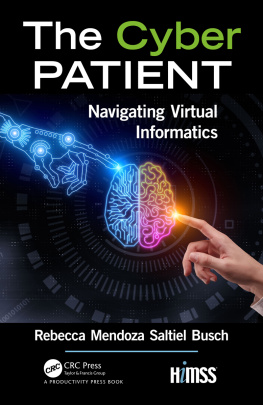eMessaging and the
Physician/Patient
Dynamic
eMessaging and the
Physician/Patient
Dynamic
Practices in Transition
Susan M. Wieczorek
LEXINGTON BOOKS
Lanham Boulder New York London
Published by Lexington Books
An imprint of The Rowman & Littlefield Publishing Group, Inc.
4501 Forbes Boulevard, Suite 200, Lanham, Maryland 20706
www.rowman.com
6 Tinworth Street, London SE11 5AL, United Kingdom
Copyright 2020 by The Rowman & Littlefield Publishing Group, Inc.
All rights reserved . No part of this book may be reproduced in any form or by any electronic or mechanical means, including information storage and retrieval systems, without written permission from the publisher, except by a reviewer who may quote passages in a review.
British Library Cataloguing in Publication Information Available
Library of Congress Cataloging-in-Publication Data Available
ISBN: 978-1-4985-5957-7 (cloth : alk. paper)
ISBN: 978-1-4985-5958-4 (electronic)
 The paper used in this publication meets the minimum requirements of American National Standard for Information SciencesPermanence of Paper for Printed Library Materials, ANSI/NISO Z39.48-1992.
The paper used in this publication meets the minimum requirements of American National Standard for Information SciencesPermanence of Paper for Printed Library Materials, ANSI/NISO Z39.48-1992.
Contents
The destabilizing nature of change induces both a reaction and a response from those experiencing it. People typically react to change by attempting to minimize its potential disruption of day-to-day events, since it can often provoke discomfort, anxiety, or even fear. Reactions involve either accepting or rejecting what is new in an attempt to return as quickly as possible to a felt state of equilibrium or perceived normalcy. For instance, if something different is introduced into the environment such as a unique product on the market or a technological invention, the immediate reaction is either to ignore the item or to experiment with it to see if it might fit into normal, everyday life as naturally and efficiently as possible. Both favorable and unfavorable reactions perpetuate the daily ebb and flow of new events that are introduced into society on a steady, ongoing basis.
Collective group reactions occur among like-minded individuals. As these patterns are recognized and acknowledged (often through the help of public and social media), this affects how well and how quickly the change filters through society. How many people are affected by these reactions often influences to what extent and in what manner the public then responds to the overall change. To understand such a collective response, a historical perspective is needed to determine the climate and situation that existed as change was introduced. At times, when looking back, the process seems rather abrupt. Many have referred to these collective responses as a take off moment (McLuhan M., 1962, p. 79) or tipping point (Gladwell, 2002) as if a precise moment in time might identify the very instance of change. Retrospectively, transitions may appear to be sudden or reactive, but those that affect the intricate system of a sociocultural environment occur as multiple, interlocking patterns of responses that pass through time and space to warrant recognition as true periods not mere moments or pointsof change.
Responses require interactive, participatory, thoughtful engagement. People ponder the ramifications of how the overall structure and nature of the environment might be altered as a result of the individual and collective reactions that first surface. Responses, though often characterized by varied levels of emotion, evolve through a process of logical reasoning and reflection. They tend to be less spontaneous and more conscious and purposeful than mere reactions to change. They often occur after considering multiple views and counter-opinions and tend to be more consistent with personal goals, beliefs, and values.
Applied adaption to something introduced to the publicparticularly that which affects our most basic methods of communicationrequires testing, challenging, retesting, and then, if desired, fully integrating the change into the sociocultural fabric of the environment. When this transition elicits reflective thought and reaction by multiple groups in society, it can affect all aspects of that environment to the point where a significant, more consequential, and far-reaching transformation may occur. The whole is constantly affected by its composite parts. Each subgroup uniquely and collectively responds to the mechanism of change, while simultaneously modifying and sustaining the dynamic organismic whole of society. This transformative process, made up of a multitude of reactions and responses from those living within this environment, evolves into a pattern of interconnected and interdependent working parts within this dynamic, adaptive space. Relatively new media of communication such as the telegraph, telephone, and television bring about particularly influential, lasting, and transformative effects on society in general and on specific spaces within society in particularin this case, the medical arena.
Studying such a process not only allows for a deeper understanding of how something new is introduced into the sociocultural fabric of an environment but also enables us to learn about the long-term effect of this process from multiple perspectives and within a variety of contexts over time. How roles are redefined, relationships developed, laws generated, policies upheld, economies challenged, public reactions and responses predicted, and so on affect how change is implemented, managed, integrated, and sustained within the sociocultural context of a given environment. Predicting behavior, anticipating problems, planning for future outcomes, and testing the change through research may jointly be facilitated by studying this process.
More specifically, when a change involves something as fundamental to human existence as communication about health, exploring the introduction to, transition through, and implementation of such a change is vitally important to understanding its effects on the multiple groups of people within the entire environment. In fact, as Thomas Kuhn once stated, Any study of paradigm-directed or of paradigm-shattering research must begin by locating the responsible group or groups ( The Structure of Scientific Revolutions , p. 179). Despite his use of the term shattering, however, Kuhn recognizes that for something to be paradigmatic, it need not be a large change, nor need it seem revolutionary to those outside a single community, and, yet, no matter how large or small, change so badly needs to be understood (p. 180). This book examines the process of how one seemingly minor changecommunicating online between physicians and patients within secured Electronic Health Record (EHR) portalsshifted the very essence of the medical relationship and healthcare in general.
Introducing Change in the Healthcare Industry: Medical Science and Technology
Change itself is a constant in the healthcare arena. Toward the end of President Barack Obamas first term in office, the healthcare setting reflected tremendous growth and development. The Bureau of Labor Statistics (2013) projected a 2.6% increase in the healthcare and social assistance sectors alone, stating that five million jobs were expected to be added to the U.S. economy between 2012 and 2022. Of these jobs, telehealth services by 2014 produced an industry revenue of $585 million with projected revenue growth of 49.5% through the end of 2015, making telehealth services the second fastest-growing industry in the United States at this time (Winfrey, 2015). The year 2015 was declared The Year of Healthcare for Wearables (Feibus, 2015), in reference not only to wristbands or ankle bands that monitored movement and exercise but to healthcare devices that monitored everything from blood glucose levels to blood pressure. With similar innovative devices coming out on a regular basis, it was projected that the annual smart wearable healthcare market volume would increase from $2 billion in 2014 to $41 billion in 2020, reflecting a compound annual growth rate of 65% (Soreon Research, 2014).










 The paper used in this publication meets the minimum requirements of American National Standard for Information SciencesPermanence of Paper for Printed Library Materials, ANSI/NISO Z39.48-1992.
The paper used in this publication meets the minimum requirements of American National Standard for Information SciencesPermanence of Paper for Printed Library Materials, ANSI/NISO Z39.48-1992.